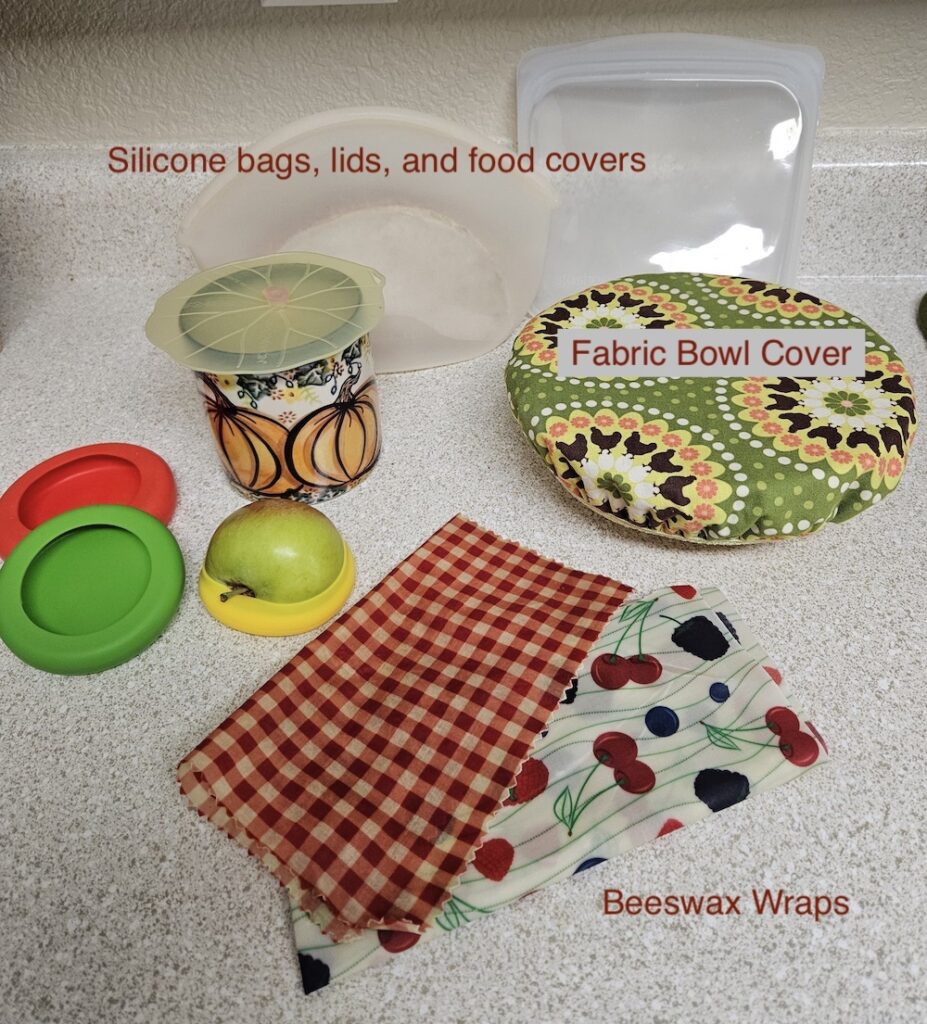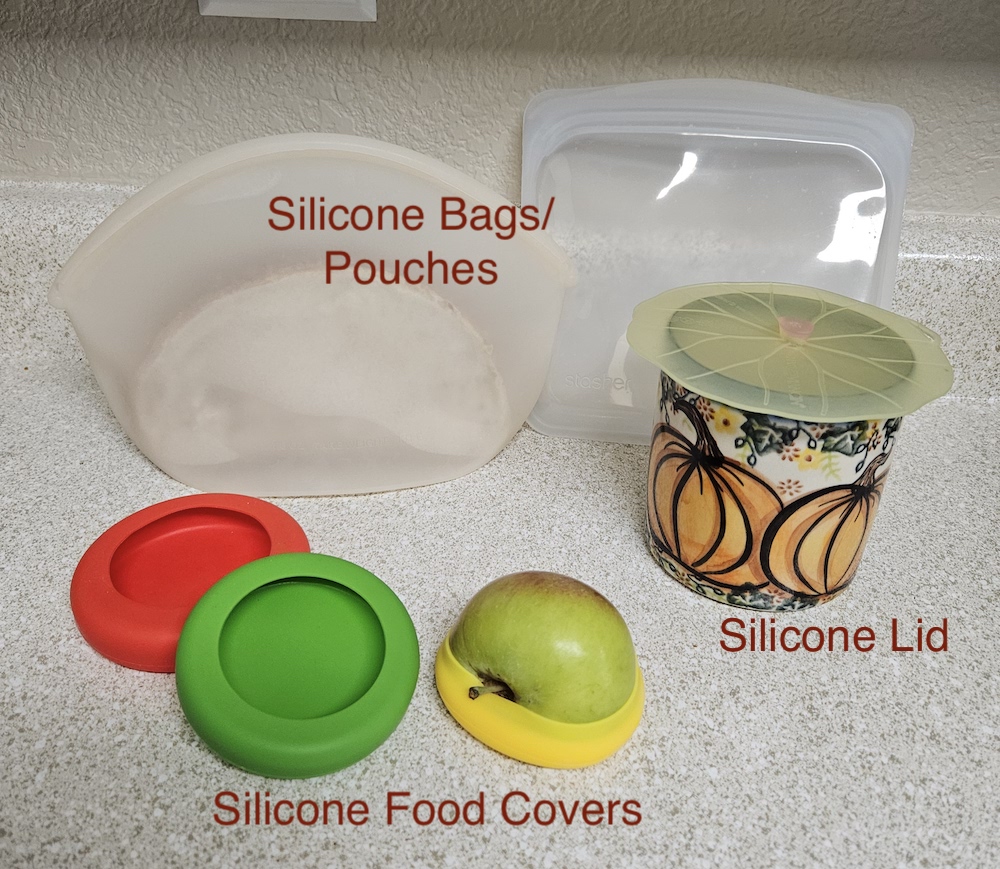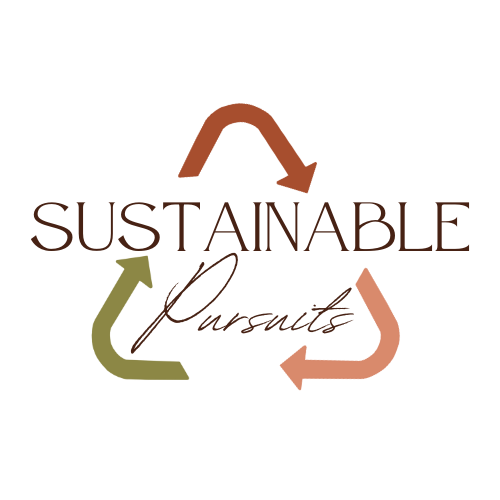
Let’s take a look at some ways to store leftovers without plastic wrap. The 3 plastic wrap alternatives that are most widely available are beeswax wrap, silicone pouches or covers, and fabric bowl covers. To decide which one will be best for you, we need to learn more about these alternatives and how to use them. This month’s plastic-free challenge is all about these 3 plastic wrap alternatives. So, I’ll be doing more evaluations on them throughout the month.
Beeswax Wrap Instead of Plastic Wrap
How to use beeswax wrap
Beeswax wrap is typically made with the natural ingredients of cotton fabric, beeswax, pine resin, and jojoba oil. With beeswax wraps, you use the heat from your hands to mold the wrap around the container or food you are trying to cover. The wax on the wrap is sensitive to heat so you shouldn’t use it when the food is hot or for reheating foods.
To care for the wrap, you will need to wash it by hand using mild detergent and cool water and then let it air dry. DO NOT wash it in hot water, it will melt off the wax coating. After so many uses the wax on the wrap will wear off and either needs to be refreshed or you can compost or find other uses for the cotton cloth.
Where to find beeswax wraps
Beeswax wrap can be purchased or made at home. I’ve found beeswax wraps at bulk food stores, zero waste stores, online, kitchen stores, gift shops, and even at farmers’ markets. You can also find instructions for how to make them at home. I haven’t tried making them myself but it looks fairly straightforward. The instructions in the book, Forgotten Ways for Modern Days*, are probably the simplest. All you need is cloth, beeswax, a cheese grater, an oven, and a baking sheet with parchment paper.
I’ve been using beeswax wraps for the last 2 years and I’ve found there are variations with them, mostly in the thickness of the wax. Some of them are more pliable than others. So if you’re able to buy them in person, make sure they have good flexibility. From what I’ve seen, the precut wraps tend to have better flexibility than the ones on a roll, which tend to be stiffer. I find that the stiffness makes them less effective because I have trouble molding them properly to the container.
When is it best to use beeswax wraps?
Beeswax wrap is best suited for foods that need short-term storage and breathability. In writing this article, I’ve learned that there are some additional uses for the beeswax wraps that I haven’t tried. Such as, using them to store cheese and fresh greens. Now that I buy block cheese I’m looking forward to seeing how well it does in the beeswax wrap.
Some DO’s and DON’TS with beeswax wrap
- DO use the wraps on foods that like breathable storage such as breads, cheese, salad mixes, fresh herbs, and fruits and veggies.
- DON’T use the wraps on raw meats, fish, and eggs (the wraps can’t be sanitized without ruining them)
- DO use them to cover foods that are fully cooled
- DON’T use them on foods that need an air-tight or water-proof seals
- DON’T put them in the dishwasher, washing machine, or wash them using hot water
Silicone instead of Plastic Wrap
How to use Silicone
Silicone rubber is made from silicon, hydrogen, carbon, and oxygen. For the most part, you can use silicone like a plastic container. However, silicone has the additional benefit of being heat resistant. Meaning, you can put it in the freezer, oven, microwave, or dishwasher, or put it in boiling water. It also creates a nonstick surface that is great for baking and easy cleanup. You can wash the silicone by hand or in the dishwasher. Silicone can be recycled at specialty recycling centers and several of the silicone manufacturers have take-back programs.
Where to find Silicone
The most prevalent silicone kitchen products are the bags, which I’ve been able to find even in big box stores. But things like the silicone bowl lids and food covers might require more searching. The food covers have a variety of sizes and are used to cover the cut portion of fruits or veggies. These can typically be found online, in bulk food stores, and in health food stores. As for the silicone bowl/mug covers, I’ve only seen these in kitchen stores and online.
When is it best to use Silicone?
Silicone does seem to have more Do’s than Don’ts when it comes to usage. As mentioned before, you can use silicone for anything you would use a plastic container for and then some. It’s like having the benefits of plastic plus the temperature resistance of glass. One thing I will caution on, I did come across this article where they are hesitant about silicone being considered chemically inert, I’ve included the link so you can decide for yourself. The other thing to be cautious about is to make sure you are getting high-quality food-grade silicone, preferably platinum quality, to avoid any problems with fillers.
A bit about silicone food covers and lids. The food covers work well to save the uncut portion but you have to have the right size covers. For the silicone lids, you create a seal on the bowl or pan by pressing down on the center of the lid. This creates a vacuum holding the lid in place. These are great for any bowls or pans that don’t have lids or if you just need to cover something. The lids for mugs also help keep your beverages warm 🙂

Fabric Bowl Covers instead of Plastic Wrap
How to use them
Fabric covers, as the name implies, are typically fabric circles with an elastic band around the edge. The elastic band helps hold the cover in place on the bowl or cup. There are 2 types of cloth covers I’ve come across. Covers are usually made with 2 layers, some are made with a cotton layer and a water-resistant layer. Some have plain cotton fabric for both layers. These can be used with hot or cold foods but don’t provide an air-tight barrier. While the covers do stretch a bit thanks to the elastic, you are limited by their size. So you will need multiple sizes if this is your preferred plastic wrap alternative.
The all-fabric covers can be machine washed and depending on the type of liner so can the lined ones. However, it’s usually better to hand wash the lined ones. They typically don’t need more than a quick wipe and rinse with soap and water anyway. If they do get really dirty, just throw them in the washing machine but be careful. I’ve had one or two get their lining morphed because I washed them in a hot water cycle. Even so, I feel like they’re pretty easy to clean and dry.
Where to find fabric bowl covers
I’ve got cloth bowl covers I’ve found in kitchen stores but the ones I like most came from craft shows. And of course, you can also order them online through sites like Amazon or Etsy. Since I’m working on my sewing skills, bowl covers are something I really want to try making myself. That way I can size them specifically for my bowls. I just ordered some eco-friendly laminated fabric so I will let you know how it goes! (Note: I don’t have an affiliate link with the fabric store, I just wanted to share the link in case you were interested in them).
Which of these plastic wrap alternatives is the best?
I wish I could answer that right now, I do have my preferences, but I’m still testing them out. I now realize I haven’t been using some of these alternatives correctly, or at least to their full capacity. For example, beeswax wrap is supposed to work well for storing cheeses and salad mix, which I have yet to try. So I won’t officially be able to say which ones I like best until I get to this month’s conclusion article.
But really, any of these 3 options will help you cut down on plastic wrap. Which one will help you the most depends on why you usually use plastic wrap to begin with. Do you use plastic wrap to save half-cut fruits and veggies? Then beeswax wrap or silicone food covers would be best for you. Do you use it mostly to cover leftover portions? Then you should look into the fabric covers and beeswax wraps. Do you use a lot of plastic baggies? Give the silicone bags a try. Personally, I use a lot of plastic wrap and baggies when it comes to freezing foods, which is why it’s one of the things I’m testing this month.
Hope this helps with deciding which alternative will work best for you. Be sure to check in later for the final evaluation of these plastic wrap alternatives.
Note: I will only recommend products that I personally use and love and hope can be of benefit to others in their sustainable journeys. (*) indicates an affiliate link where Sustainable Pursuits llc may receive a small compensation for product recommendations. This helps to support Sustainable Pursuits llc and my ability to share these experiences with you!

